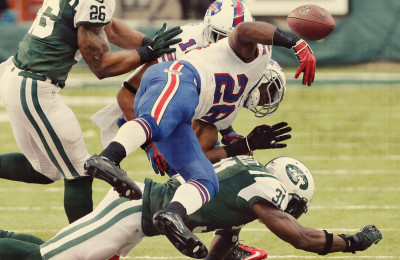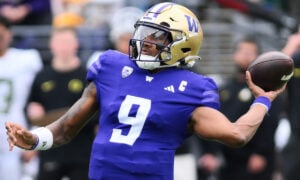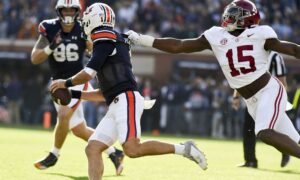Then and Now: Running Backs
“As the present now will later be past, the order is rapidly fadin’. And the first one now will later be last, for the times they are a changin’.”
– Bob Dylan
 What a difference a year can make. Only seven short weeks into the season, the NFL has already been awash in a sea of change including such events as the Kansas City Chiefs starting off the year as the only unbeaten team, the previously moribund Cleveland Browns outperforming division rival Pittsburgh, and prior NFC heavyweight Atlanta already losing more games than they did all of 2012. Not shockingly, this restructuring has impacted multiple players in the fantasy landscape as well.
What a difference a year can make. Only seven short weeks into the season, the NFL has already been awash in a sea of change including such events as the Kansas City Chiefs starting off the year as the only unbeaten team, the previously moribund Cleveland Browns outperforming division rival Pittsburgh, and prior NFC heavyweight Atlanta already losing more games than they did all of 2012. Not shockingly, this restructuring has impacted multiple players in the fantasy landscape as well.
Put another way, we set our pre-season expectations largely based off of a year’s worth of evidence from last season. We observed these trends in order to help clarify the outlooks of many players of interest, but now have a reasonable amount of current data in hand. So – what’s changed?
This short series sets out to answer that very question. This four-part breakdown will look at the top ten players at each position from 2012, and compare how they’re performing so far in 2013. From there we can decide if it’s time to reset our expectations in order to predict the potential results for the remainder of the season.
In order to do so, it’s time to bust out some statistics, and by now it’s no secret to the DLF masses that I’m a huge proponent of efficiency metrics. Instead of explaining this affinity yet again, I’ll just refer you here, here, here, here and here. Simply put, in my opinion it’s the best way to not only compare apples to apples, but to essentially pluck them from the identical branch of the same metaphorical tree.
In that spirit, key efficiency metrics will be used in order to judge each player’s progression (or regression) in the past year. I’ll also include rationale as to why things could be going the way they are, as well as insight towards the future. Let’s continue with the running backs!
Before we dive into the data, here’s a list of abbreviations and explanations for the key terms used:
Fantasy Points Per Game (PPG) – Each player’s weekly output according to standard WCOFF PPR scoring.
Touchdowns Per Game (TDPG) – Total touchdowns, both rushing and receiving, divided by the number of games played.
Rush Attempts Per Game (RAPG) – A player’s average weekly rushing attempts.
Receptions Per Game (RPG) – A player’s average weekly receptions.
Points Per Touch (PPT) – A player’s total fantasy points divided by the aggregate amount of his rushes and receptions.
True Points Per Touch (TPPT) – Take a player’s total PPR fantasy points and subtract out the points scored from touchdowns and receptions (note: only the point-per-reception is removed, not the points for receiving yardage). Next, take the resultant total and divide it by a running back’s total touches. The remaining number is the “true” summation of the running back’s rate of scoring, and an accurate depiction of how well the running back performs with the ball in his hands.
Percent Changes (% Change) – This shows the differences for each metric between 2012 and 2013.
Let’s get started! (Editor’s note: All 2013 statistics include only the first six weeks of the season)
Adrian Peterson, RB MIN
|
Year |
Rank |
PPG |
TDPG |
RAPG |
RPG |
PPT |
TPPT |
|
2012 |
1 |
21.8 |
0.81 |
21.8 |
2.5 |
0.900 |
0.596 |
|
2013 |
6* |
21.1 |
1.20 |
20.4 |
2.8 |
0.910 |
0.479 |
|
% Change |
– |
-3.2 |
48.2 |
-6.4 |
12.0 |
1.1 |
-19.6 |
* denotes the player has already had his bye week
Then and Now: After a transcendent 2012 season that saw him rush for over 2,000 yards, Peterson’s fantasy pace has barely dipped. What has changed, however, is the manner in which he’s doing it. Gone is the nearly unrivaled way that Peterson carved out yards on a per-touch basis (see the 19.6% drop-off in TPPT), replaced by an even stronger rate of scoring. Regardless, even with the drop-off in True Point efficiency, Peterson remains a top asset.
Future Prognosis: Peterson’s current rate of scoring would lead to a total of 19 touchdowns this year, which would beat his previous career high of 18 in 2009. Though that rate should prove to be unsustainable, AP has now strung together back-to-back games of over six yards-per-carry, and his TPPT over that stretch is a significantly higher value of 0.619. With new quarterback Josh Freeman potentially opening up the field, I believe Peterson is in line to replicate his 2012 greatness.
Doug Martin, RB TB
|
Year |
Rank |
PPG |
TDPG |
RAPG |
RPG |
PPT |
TPPT |
|
2012 |
2 |
19.6 |
0.75 |
19.9 |
3.1 |
0.852 |
0.523 |
|
2013 |
20* |
12.8 |
0.20 |
23.2 |
2.2 |
0.502 |
0.369 |
|
% Change |
– |
-34.7 |
-73.3 |
16.6 |
-29.0 |
-41.1 |
-29.4 |
* denotes the player has already had his bye week
Then and Now: Can we call it a sophomore slump yet? Martin’s numbers have fallen across the board despite a 16.6% increase in his weekly carries. The cold hard facts are he’s just not catching the ball, scoring or churning out yards as well as he did as a rookie in 2012. He’s remained on the fantasy radar mostly due to volume alone.
Future Prognosis: Rookie signal caller Mike Glennon should continue to improve as the season goes on, but until then expect the Muscle Hamster to face significantly more defensive attention than he received last year. As strong as he appears, Martin seems to be crushed under the burden of unrealized expectations. (Editor’s note: This was written prior to Sunday’s injury)
Arian Foster, RB HOU
|
Year |
Rank |
PPG |
TDPG |
RAPG |
RPG |
PPT |
TPPT |
|
2012 |
3 |
19.1 |
1.06 |
21.9 |
2.5 |
0.780 |
0.416 |
|
2013 |
7 |
17.6 |
0.33 |
19.5 |
3.7 |
0.758 |
0.514 |
|
% Change |
– |
-7.9 |
-68.9 |
-11.0 |
48.0 |
-2.8 |
23.6 |
Then and Now: Last season Foster mainly benefited from two things – volume and scoring opportunities. Ironically enough, so far this year he’s running better than he did at any point in 2012, but lacks the touchdowns that came to him so easily before. He’s touching the ball more in the passing game and gaining yardage at a significantly better clip, but his points per touch (and overall player rank) have dropped due to being held out of the end zone.
Future Prognosis: Shockingly enough, the Texans are a downright bad team. With the inexperienced Case Keenum currently under center and the defense not playing up to their 2012 levels, it’s unreasonable to expect Houston to be in a position to salt away games by running the ball. Foster (and by proxy, Ben Tate) will likely be leaned on more in the early portions of each weekly contest, but the overall numbers and scoring chances figure to stay down.
Ray Rice, RB BAL
|
Year |
Rank |
PPG |
TDPG |
RAPG |
RPG |
PPT |
TPPT |
|
2012 |
4 |
17.7 |
0.63 |
16.1 |
3.8 |
0.893 |
0.510 |
|
2013 |
18* |
13.3 |
0.60 |
14.2 |
4.0 |
0.730 |
0.312 |
|
% Change |
– |
-24.9 |
-4.8 |
-11.8 |
5.3 |
-18.3 |
-38.8 |
*denotes player missed a game due to injury
Then and Now: To say Rice has underperformed thus far in 2013 is like saying the Grand Canyon is just some crack in the ground. Sticking with the geographic metaphor, there has been a chasm between Rice’s numbers from last season and this one, and he’s fallen off a cliff in every statistical category except receptions per game. Averaging career worsts in yards-per-carry (2.8) and yards-per-catch (4.4), he hasn’t even remotely resembled the first round selection many undoubtedly made him in off-season startup drafts.
Future Prognosis: In fairness to Rice, the entire Ravens’ offense (sans receiver Torrey Smith) has taken a giant step back, and it’s not as if backup runner Bernard Pierce (2.8 YPC) is faring any better. The addition of mauling tackle Eugene Monroe helps, as should a complete return to health following a week two hip injury. Regardless, Rice appears to be more of a RB2 than the elite RB1 he’s been for the past few seasons.
Marshawn Lynch, RB SEA
|
Year |
Rank |
PPG |
TDPG |
RAPG |
RPG |
PPT |
TPPT |
|
2012 |
5 |
17.1 |
0.75 |
19.7 |
1.4 |
0.809 |
0.528 |
|
2013 |
5* |
19.2 |
1.00 |
19.5 |
2.2 |
0.885 |
0.508 |
|
% Change |
– |
12.3 |
33.3 |
-1.0 |
57.1 |
9.4 |
-3.8 |
*Does not include his week seven performance
Then and Now: In what has been a year of upheaval at the running back position, Lynch has been a fantasy rock. His numbers are mostly up across the board, including a current average of one score per game. He’s been slightly worse at gaining yardage per touch, but has mitigated this with increased usage in the passing game. He is who we thought he is – something we haven’t been able to say for many other top running backs thus far in 2013.
Future Prognosis: The Seahawks are what they are, which is a run-first, defensive-minded football team. More importantly, in Pete Carroll’s offense the backup ball carrier rarely ever totes the rock. The potential midseason addition of Percy Harvin could lead to a few more passing attempts per game, but should also open up bigger running lanes for Beast Mode – he’ll remain a high-end RB1.
CJ Spiller, RB BUF
|
Year |
Rank |
PPG |
TDPG |
RAPG |
RPG |
PPT |
TPPT |
|
2012 |
6 |
16.3 |
0.50 |
12.9 |
2.7 |
1.045 |
0.681 |
|
2013 |
25 |
9.7 |
0.17 |
14.0 |
2.0 |
0.607 |
0.420 |
|
% Change |
– |
-40.4 |
-66.0 |
8.5 |
-25.9 |
-41.9 |
-38.3 |
Then and Now: In 2012 Spiller was the darling of metrics geeks (like myself) everywhere. Despite a smaller number of touches when compared to the top running backs, he was able to put up RB1-level numbers due to his off-the-charts efficiency. With the promise of an increased workload in 2013, the future appeared bright. Unfortunately, Spiller just hasn’t been the same guy – he’s fought through an ankle injury which has sapped his explosiveness, and he’s just not doing anything as well as he has last year. He’s currently the second best fantasy ball carrier on his own team, behind the apparently ageless Fred Jackson.
Future Prognosis: It’s hard for me to believe that Spiller simply “lost it” this year. The Buffalo offense has been a work in progress, receiving bottom of the barrel play from the quarterback position, and top receiver Stevie Johnson has been in and out of the lineup. When he regains his health and the offense finds an identity, I expect Spiller’s play to improve, even if he isn’t able to replicate his otherworldly 2012 output.
Alfred Morris, RB WSH
|
Year |
Rank |
PPG |
TDPG |
RAPG |
RPG |
PPT |
TPPT |
|
2012 |
7 |
16.1 |
0.81 |
20.9 |
0.7 |
0.744 |
0.486 |
|
2013 |
21* |
12.2 |
0.60 |
14.4 |
0.6 |
0.791 |
0.532 |
|
% Change |
– |
-24.2 |
-25.9 |
-31.1 |
-14.3 |
6.3 |
9.5 |
* denotes the player has already had his bye week
Then and Now: As a rookie, Morris seemingly came out of nowhere en route to totaling the second highest rushing output in the league. And though the overall ranking doesn’t reflect it, he’s actually been better so far in 2013. Despite scoring less, his PPT has increased. He’s also been better with the ball in his hands, averaging 5.2 yards-per-carry and increasing his TPPT by nearly 10%. Unfortunately, the Redskins have constantly been forced to play from behind, leading to a precipitous 31.1% drop-off in weekly rushing attempts.
Future Prognosis: If week six was any indicator, it appears Washington is ready to rely once again on the read option as a focal point of the offense. Doing so can only help Morris, as the threat of quarterback Robert Griffin III tucking and running forces a new level of respect from opposing defenses. I believe he’ll return to the RB1 ranks sooner rather than later, and he makes for an attractive buy low target.
Trent Richardson, RB IND
|
Year |
Rank |
PPG |
TDPG |
RAPG |
RPG |
PPT |
TPPT |
|
2012 |
8 |
17.0 |
0.80 |
17.8 |
3.4 |
0.803 |
0.414 |
|
2013 |
26 |
9.6 |
0.33 |
15.3 |
1.5 |
0.570 |
0.362 |
|
% Change |
– |
-43.5 |
-58.8 |
-14.0 |
-55.9 |
-29.0 |
-12.6 |
Then and Now: Six. That’s the number of “negative” signs you see in the bottom row of the table above, signifying the second sophomore slump for the 2012 rookie running backs. While I don’t believe Richardson has been as bad as the numbers make him look, the fact is he’s lost volume, scoring opportunities and production in the passing game so far in 2013. Though an in-season trade to the Colts helps explain his recent woes, I’m sure I’m not along in suggesting we expected more.
Future Prognosis: A week six tilt with the Chargers marked T-Rich’s fourth game with the Colts, and also the fourth consecutive game his yards-per-carry value increased. He’s clearly getting used to Indy’s system, and I think his talent is primed to shine through sooner rather than later. The unexplainable drop in receptions hurts, but in my opinion Richardson remains an improving workhorse.
Jamaal Charles, RB KC
|
Year |
Rank |
PPG |
TDPG |
RAPG |
RPG |
PPT |
TPPT |
|
2012 |
9 |
15.4 |
0.38 |
17.8 |
2.3 |
0.772 |
0.547 |
|
2013 |
1 |
25.4 |
1.17 |
19.0 |
5.5 |
1.037 |
0.609 |
|
% Change |
– |
64.9 |
207.9 |
6.8 |
139.1 |
34.3 |
11.3 |
Then and Now: Just call him the Peyton Manning of running backs! Due largely in part to expected bumps in passing game usage and scoring opportunities, Charles has pulled away from the rest of the running back field so far in 2013. Averaging, literally, hundreds of percent better in these two values than he did in 2012, Charles is arguably fantasy’s most ascendant player. Given the combination of efficiency and workload, I see no reason for Charles to relinquish the figurative title of fantasy’s best running back.
Future Prognosis: Charles is essentially matchup proof. His ability to catch the ball alleviates the pressures of facing off with top run defenses, and he constantly gets the nod in goal-to-go situations. If not for the afore-mentioned Manning, as well as the Saints’ Jimmy Graham, Charles would be in the running for overall fantasy MVP.
Frank Gore, RB SF
|
Year |
Rank |
PPG |
TDPG |
RAPG |
RPG |
PPT |
TPPT |
|
2012 |
10 |
14.2 |
0.56 |
16.2 |
1.8 |
0.790 |
0.504 |
|
2013 |
16 |
12.7 |
0.50 |
17.2 |
0.8 |
0.706 |
0.494 |
|
% Change |
– |
-10.6 |
-10.7 |
6.2 |
-55.6 |
-10.6 |
-2.0 |
Then and Now: Ho-hum. Gore just keeps churning out consistent production, and every metric listed above (apart from receptions per game) is eerily similar to the 2012 values. He remains an integral part of a run-heavy offense lacking playmakers in the receiving game, and is an ideal low-end RB1/high-end RB2.
Future Prognosis: After averaging only 13.7 carries the first three weeks, Gore is up to 20.7 since. During that time he’s also scored twice, averaging 0.734 PPT and 0.540 TPPT. Now exerting control of the offense, expect Gore to threaten for another top-10 running back finish.
Stay tuned for the WR and TE positions over the next two days. You can follow me on Twitter @EDH_27
- Dynasty Fantasy Football Mailbag: Justin Jefferson Or A Bundle Of Draft Picks? - April 23, 2024
- Dynasty Fantasy Football Mailbag: Is Kendre Miller Valued Unfairly? - April 17, 2024
- Forgotten Dynasty Veterans: Bottom Tier - April 9, 2024


































































